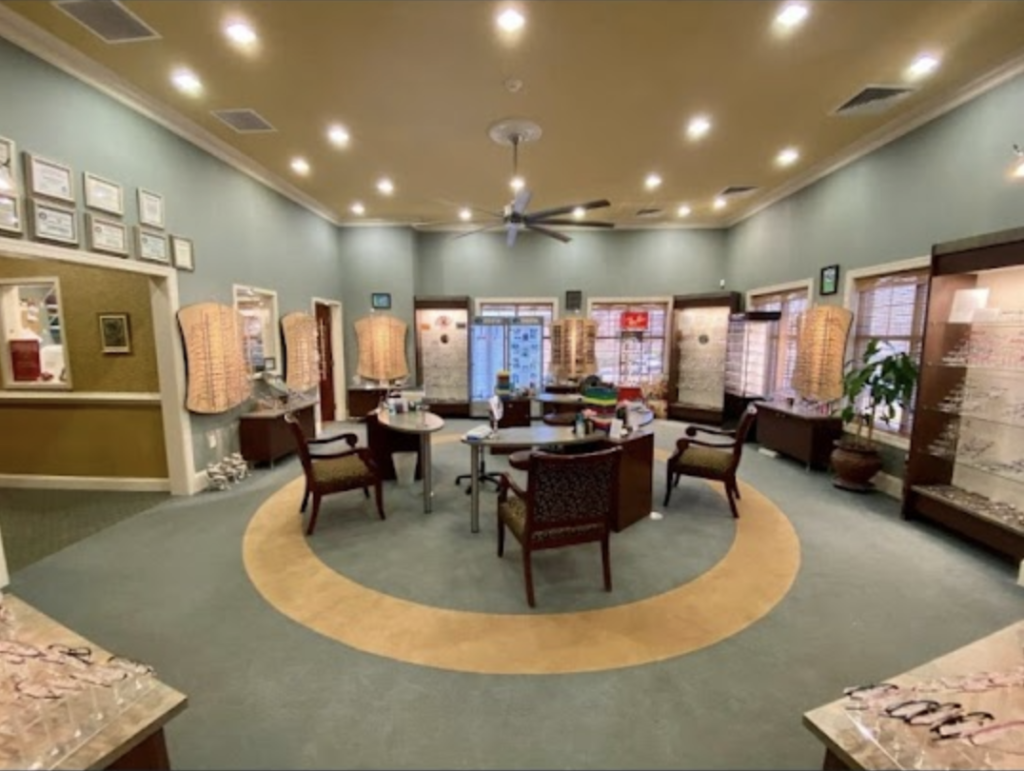
We Have a Complete Selection of Designer Glasses and Sunglasses for the entire family
We offer frames for every budget
Contact Lenses
Rec Specs for sports
Adjustments and Repairs
Why choose us? Quality, Selection, Expert Opticians, Convenience,
This Is How We See?
Here is how we see, light rays enter the eye through the cornea, pupil and lens. The cornea is the clear, round dome covering the iris, the colored ring in the center of the eye, and the pupil, the black circle in the middle of the iris. The light rays then pass through the vitreous, a clear, gel-like substance that fills the middle of the eye, and are focused on the retina, a light-sensitive tissue lining the back of the eye.
The macula is a very small area at the center of the retina that gives us our fine, pinpoint central vision. The area of retina surrounding the macula gives us our peripheral — or side — vision. The retina converts light rays into impulses that are sent through the optic nerve to your brain, where they are recognized as images.
By helping to focus light as it enters the eye, the cornea and the lens both play important roles in giving us clear vision. In fact, 70% of the eye’s focusing power comes from the cornea and 30% from the lens.
Wearing eyeglasses is an easy way to correct refractive errors. Improving your vision with eyeglasses offers the opportunity to select from different types of lens options, frame designs and even lens coatings for various purposes.
Types of Eyeglasses
There are two different types of eyeglass lens designs: single vision, an all-purpose lens designed to correct distance vision, and multifocal, designed to correct both distance vision and near vision (the upper portion is focused for distance vision, while the bottom portion is used for up close activities such as reading).
Multifocal lenses are eyeglasses used to correct presbyopia, the eye’s natural diminished ability to focus on near objects that comes with age. Bifocals have a correction for reading on the bottom half of the lens and another for seeing at a distance on the top. Some specialized lenses may also have segments at the top for those who need to look upward at objects that are in the intermediate or near range (double-D bifocals). Trifocals are lenses with three different lens corrections — distance vision, intermediate vision, and near vision — in one set of eyeglasses. Progressive lenses function generally the same way as bifocals or trifocals; however, they have a smooth transition between distance and near focal areas instead visible dividing lines. While the invisible transition of progressive lenses may be more aesthetically pleasing, the focal areas are relatively small because more lens space is used for the transitional areas. Progressive lenses cause more distortion than other types of lenses, making them more difficult to wear for approximately 10 percent of the population.
If you don’t need correction for seeing at a distance, you can get reading glasses (also called readers) over the counter at drugstores, bookstores and many other retail shops to correct presbyopia. You can also get a prescription for reading glasses from your eye care provider.
No exercise or medication can reverse presbyopia. Delaying the use of reading glasses is of no benefit. You will probably need to change your eyeglass prescription from time to time between the ages of 40 and 60 because your eye’s natural lens will continue to lose flexibility and, therefore, focusing ability.
Types of Eyeglass Lens Materials
Eyeglass lenses used to be made only of glass, but today most lenses are plastic. Plastic lenses are lighter, more flexible, and safer because they are less likely to shatter. They also have inherent UV light-blocking ability.
For people who wear eyeglasses during sports or other activities that can result in eye injuries, eye doctors often recommend polycarbonate lenses, a safety lens material that is highly impact resistant.
Trivex is a newer plastic material that meets the same safety standards as polycarbonate, but it is less distorting.
Another type of lens is a thin, light, plastic lens called a “high index” lens. These are recommended for people who need high visual correction. Because they have a thin profile, they eliminate the “coke bottle” appearance that often comes with thick-lensed glasses.
Types of Eyeglass Lens Protective Coatings
Protective coatings for eyeglasses are available to help you keep your eyes healthy.
Anti-reflective coatings help to diminish reflections off the surface of your glasses, thereby allowing others to make eye contact with you more effectively and improving your appearance. Coated lenses allow more light to pass through them, improving contrast sensitivity and visual acuity. Because of reduced glare and reflections, eyestrain may be reduced. Some of these coatings can be especially helpful for people who are bothered by glare from headlights and other lights while driving at night.
Another type of coating helps to protect your eyes from the harmful radiation of ultraviolet (UV) light. This type of coating may not be needed on some types of plastic lenses, because they inherently block UV light.
Another option for vision correction with UV protection is prescription sunglasses. Also, for people who prefer one set of eyeglasses for both inside and outdoors, photochromatic lenses are a good option. Photochromatic lenses have a tint that varies based on their light exposure, with a darker tint in sunlight and lighter indoors. A disadvantage of photochromatic lenses is that they do not work well in cars or airplanes, because the windows block the light rays that trigger the change in lens tint. It may take several minutes for the lens tint to change from dark to light.
